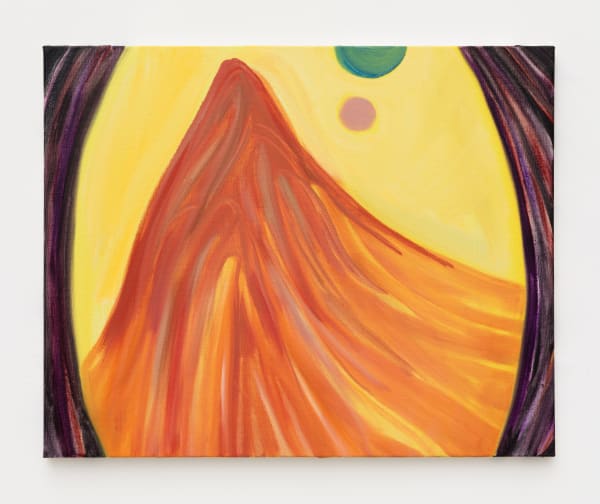Éveils Maritimes Marina Perez Simão
Past exhibition
Overview
Marina Perez Simão’s paintings are characterized above all by their intrinsic ambiguity. Operating between abstraction and figuration, her works are populated by mostly undefined forms, which are executed with fluid and sinuous brushstrokes. Despite this – or perhaps because of this – it is possible to broadly recognize them as landscapes. In some cases, we find examples of a more explicit iconography. Elements such as the sun, the moon, a lake, and a mountain range are clearly identifiable and rendered in a schematic, almost archetypal manner. Furthermore, several paintings are structured around a compositional pattern that allows us to recognize the sky, the horizon and a layer of the Earth’s crust.
However, far from offering us a sense of perspective or depth of field, these elements appear condensed in a single plane, each of them delimited by blocks of pulsating color, with different temperatures but similar intensity. The latent tension that emerges even in the works that employ a less vibrant palette is the result of an expressive, urgent brushstroke. All these elements are articulated according to the painting’s own internal logic, in a game that constantly oscillates between the recognizable – in this case, landscape as one of painting’s most traditional genres – and something that resists being easily revealed. Undoubtedly, what matters most here is not external reality but something that happens within the painting, suggesting the construction of an interior symbolic field.
Perhaps this is why we find recurrent motifs in many of her works. In this latest series of paintings, cosmic bodies often appear duplicated, sometimes mirrored in suggestive shapes embedded in the entrails of the earth. In a similar gesture of muddling up conventional representations of landscape, mountains seem to emerge from the bottom section of the composition that would logically correspond to subterranean strata, while in one case the schematic treatment of a body of water is replicated on the sky.
Beyond their formal ambiguity – as everything in these works only “appears to be” and there are no guarantees that anything “is” – these images also show a semantic ambiguity, constantly oscillating between seduction and repulsion, the bucolic and the apocalyptic, expansion and claustrophobia, without ever being fixated on a single place. At first, they captivate us with their familiarity (for being landscapes) and a certain use of color that often evokes folk or outsider art (I am thinking here of Lorenzato and Forrest Bess). But this affable or accessible side coexists with a sense of strangeness triggered by a somewhat violent gesture, clear boundaries denoting impenetrability, and the solitude of a largely post-human world.
The imagery found in the work of Marina Perez Simão emerges from various literary sources, which are often made explicit in her exhibition titles. However, rather than directly referencing these sources, her paintings materialize through a process of loose transposition of word into image that preserve different moods, intensities and symbolisms that suggest non-linear and open-ended narratives. The works presented in Éveils Maritimes specifically revolve around Arthur Rimbaud’s 1871 Le Bateau Ivre (The Drunken Boat), a poem written from the viewpoint of a boat that is adrift in the open sea after having lost its haulers - a kind of parable about life and art in which loss of control leads to spiritual or aesthetic redemption. Rimbaud’s account of the boat’s journey seamlessly merges images of annihilation and creation, perhaps suggesting that the forces of freedom and destruction are inextricably bound.
Likewise, always inhabiting a zone of indefinition, the interior worlds created by Marina Perez Simão reject the assertiveness of traditional binary categories, and in doing so are able to get closer to a truer picture of human experience where the pulsations of life and death are constantly intertwined.
– Kiki Mazzucchelli
However, far from offering us a sense of perspective or depth of field, these elements appear condensed in a single plane, each of them delimited by blocks of pulsating color, with different temperatures but similar intensity. The latent tension that emerges even in the works that employ a less vibrant palette is the result of an expressive, urgent brushstroke. All these elements are articulated according to the painting’s own internal logic, in a game that constantly oscillates between the recognizable – in this case, landscape as one of painting’s most traditional genres – and something that resists being easily revealed. Undoubtedly, what matters most here is not external reality but something that happens within the painting, suggesting the construction of an interior symbolic field.
Perhaps this is why we find recurrent motifs in many of her works. In this latest series of paintings, cosmic bodies often appear duplicated, sometimes mirrored in suggestive shapes embedded in the entrails of the earth. In a similar gesture of muddling up conventional representations of landscape, mountains seem to emerge from the bottom section of the composition that would logically correspond to subterranean strata, while in one case the schematic treatment of a body of water is replicated on the sky.
Beyond their formal ambiguity – as everything in these works only “appears to be” and there are no guarantees that anything “is” – these images also show a semantic ambiguity, constantly oscillating between seduction and repulsion, the bucolic and the apocalyptic, expansion and claustrophobia, without ever being fixated on a single place. At first, they captivate us with their familiarity (for being landscapes) and a certain use of color that often evokes folk or outsider art (I am thinking here of Lorenzato and Forrest Bess). But this affable or accessible side coexists with a sense of strangeness triggered by a somewhat violent gesture, clear boundaries denoting impenetrability, and the solitude of a largely post-human world.
The imagery found in the work of Marina Perez Simão emerges from various literary sources, which are often made explicit in her exhibition titles. However, rather than directly referencing these sources, her paintings materialize through a process of loose transposition of word into image that preserve different moods, intensities and symbolisms that suggest non-linear and open-ended narratives. The works presented in Éveils Maritimes specifically revolve around Arthur Rimbaud’s 1871 Le Bateau Ivre (The Drunken Boat), a poem written from the viewpoint of a boat that is adrift in the open sea after having lost its haulers - a kind of parable about life and art in which loss of control leads to spiritual or aesthetic redemption. Rimbaud’s account of the boat’s journey seamlessly merges images of annihilation and creation, perhaps suggesting that the forces of freedom and destruction are inextricably bound.
Likewise, always inhabiting a zone of indefinition, the interior worlds created by Marina Perez Simão reject the assertiveness of traditional binary categories, and in doing so are able to get closer to a truer picture of human experience where the pulsations of life and death are constantly intertwined.
– Kiki Mazzucchelli
Works
-
 Marina Perez Simão, Untitled, 2020
Marina Perez Simão, Untitled, 2020 -
 Marina Perez Simão, Untitled, 2020
Marina Perez Simão, Untitled, 2020 -
 Marina Perez Simão, Untitled, 2020
Marina Perez Simão, Untitled, 2020 -
 Marina Perez Simão, Untitled, 2020
Marina Perez Simão, Untitled, 2020 -
 Marina Perez Simão, Untitled, 2019
Marina Perez Simão, Untitled, 2019 -
 Marina Perez Simão, Untitled, 2020
Marina Perez Simão, Untitled, 2020 -
 Marina Perez Simão, Untitled, 2020
Marina Perez Simão, Untitled, 2020 -
 Marina Perez Simão, Untitled, 2020
Marina Perez Simão, Untitled, 2020 -
 Marina Perez Simão, Untitled, 2020
Marina Perez Simão, Untitled, 2020 -
 Marina Perez Simão, Untitled, 2020
Marina Perez Simão, Untitled, 2020 -
 Marina Perez Simão, Untitled, 2020
Marina Perez Simão, Untitled, 2020 -
 Marina Perez Simão, Untitled, 2020
Marina Perez Simão, Untitled, 2020 -
 Marina Perez Simão, Untitled, 2020
Marina Perez Simão, Untitled, 2020 -
 Marina Perez Simão, Untitled, 2020
Marina Perez Simão, Untitled, 2020 -
 Marina Perez Simão, Untitled, 2020
Marina Perez Simão, Untitled, 2020 -
 Marina Perez Simão, Untitled, 2020
Marina Perez Simão, Untitled, 2020 -
 Marina Perez Simão, Untitled, 2020
Marina Perez Simão, Untitled, 2020 -
 Marina Perez Simão, Untitled, 2020
Marina Perez Simão, Untitled, 2020
Installation Views




















